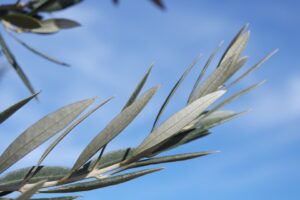 Olea Europaea (Olive) Leaf Extract*
Olea Europaea (Olive) Leaf Extract*
Olive Tree
The Olive is an evergreen tree or shrub native to the Mediterranean, Asia and parts of Africa. It is short and squat, and rarely exceeds 8-15 meters in height. The silvery green leaves are oblong in shape, measuring 4-10 cm long and 1-3 cm wide. The trunk is typically gnarled and twisted. The small white flowers, with four-cleft calyx and corolla, two stamens and bifid stigma, are borne generally on the last year s wood, in racemes springing from the axils of the leaves. The fruit is a small drupe 1-2.5 cm long, thinner-fleshed and smaller in wild plants than in orchard cultivars. Olives are harvested at the green stage or left to ripen to a rich purple color (black olive).
The olive is one of the plants most cited in recorded literature. In Homer s Odyssey, Odysseus crawls beneath two shoots of olive that grow from a single stock. The Roman poet, Horace mentions it in reference to his own diet, which he describes as very simple: “As for me, olives, endives, and smooth mallows provide sustenance”.
Lord Monboddo comments on the olive in 1779 as one of the foods preferred by the ancients and as one of the most perfect foods.
Rich in monosaturated fats, olive oil is not only healthy to eat but it is also an excellent source of antioxidants, vitamin E and K, squalene, beta-carotene, chlorophyll, flavonoids and polyphenols.
Antioxidants help slow the aging process as they neutralize the free radicals -the main agents responsible for the aging. Olive oil contains some of the most efficient antioxidants like polyphenols. It is antiseptic, anti-inflammatory, and an excellent skin toner. Olive oil may improve rheumatic conditions, inflamed, irritated skin and sensitive skin.
People in the Mediterranean have been aware of these beneficial properties for a long time so they used olive oil as a nutrient and skin care agent.
Click here to see a presentation with the olive oil properties for skincare.





